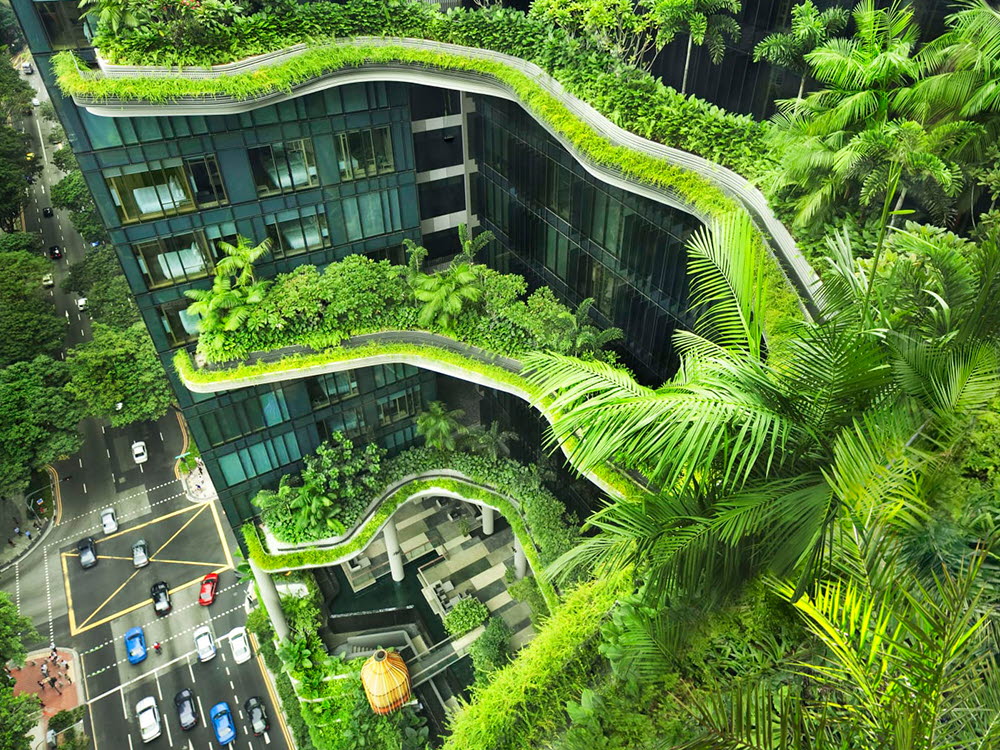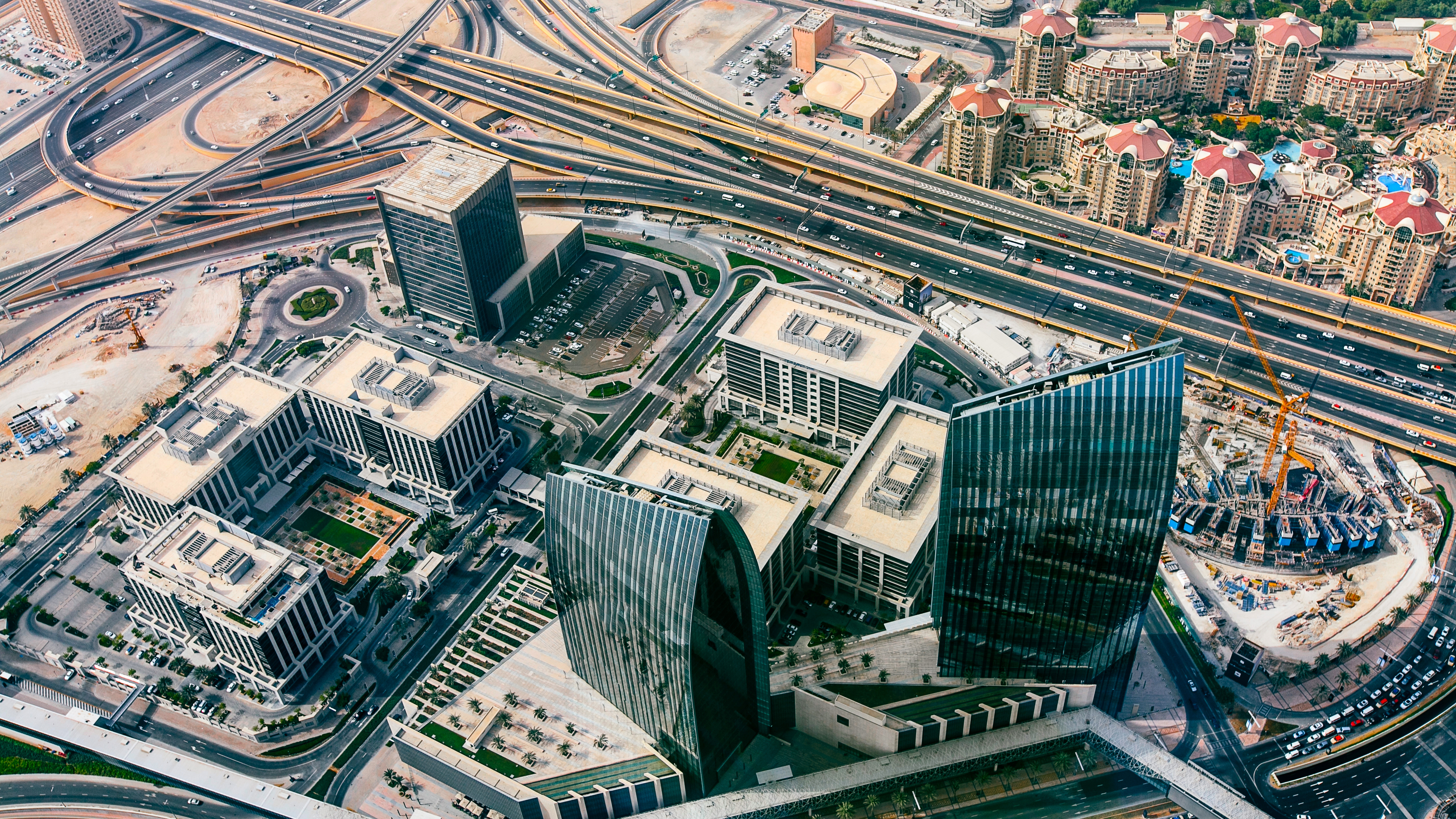
The built environment is crucial to the United Arab Emirates' (UAE's) extraordinary and rapid ascent: since its foundation in 1971, the country has constructed the world's tallest building and largest shopping mall. That scale of development has undoubtably made the UAE the success it is today – but has come at a cost.
The World Economic Forum estimates that 40% of global carbon emissions come from buildings and infrastructure, and the lion's share of these come from ongoing building operation.
The energy consumption of buildings in the UAE is among the highest in the world, with modern living in the Arabian Peninsula necessitating 24-hour air conditioning in malls, homes and offices.
UAE committing to zero carbon
The UAE is aware of these challenges, and over the past decade has made encouraging, albeit small-scale, moves to regulate and encourage the construction and operation of green buildings – or at least, greener ones – as discussed below.
But at a broader scale, the UAE is taking a regional and global lead. In 2019, it was one of the first countries to commit to the Zero Carbon Buildings for All initiative launched at the UN secretary-general's Climate Action Summit in New York.
In the same year, the UAE signed up to the 2015 Paris Agreement to limit global temperature increase to less than 1.5°C.
To support this, the World Green Building Council – of which the Emirates Green Building Council (GBC) is a part – launched the Net Zero Carbon Buildings Commitment at the 2019 summit. This commitment aims for all new and existing buildings to operate at net zero by 2030 and 2050 respectively.
The EmiratesGBC later launched the Net Zero Centre of Excellence to advance sustainable building.
Abu Dhabi's Pearl system promotes sustainable building
In addition to national commitments, individual Emirates have developed their own measures to reduce the built environment's carbon emissions.
Abu Dhabi was the first of the seven Emirates to adopt a dedicated green building certification regime with the introduction of the 2010 Pearl Building Rating System (PBRS). This was developed by the Abu Dhabi Urban Planning Council as part of Estidama, a building methodology whose name is the Arabic word for sustainability.
The PBRS aims 'to promote the development of sustainable buildings and improve quality of life', 'encourag[ing] water, energy and waste minimisation, local material use and … improv[ing] supply chains for sustainable and recycled materials and products'.
It rates buildings throughout their life cycles from design to construction and operation, and comprises three rating systems for communities, buildings and villas respectively.
Each system contains mandatory and optional standards, and credits are awarded to buildings that meet defined environmental standards. Where all mandatory standards are met, 1 Pearl is awarded. The highest rating is 5 Pearl.
Credits are available across seven categories: integrated development process, natural systems, liveable buildings, water, energy, material stewardship and innovative practice.
Each category has a set of mandatory standards applicable to all new development – for example, installing water meters to monitor consumption – that do not themselves earn credits.
Once these are met, though, optional credits can then be earned under each category; for example, one credit is earned for liveable buildings by designating 6% of parking spaces to electric, hybrid or car-pooling vehicles.
The number of credits available for meeting different optional standards varies between buildings; for instance, a retail property will receive fewer points for meeting liveable building standards as it is not intended for that purpose.
This allows for a flexibility in achieving sustainability, reflecting the practical use of different buildings and the key areas that need to be addressed in different sectors.
Unlike other voluntary international rating systems, such as the US's LEED and UK's BREEAM, the PBRS is incorporated into Abu Dhabi's building code, and certain minimum standards are mandatory to achieve building certificates.
All new buildings in Abu Dhabi must achieve a 1 Pearl rating, and all buildings that receive 50% or more of their funding from the government – including schools, mosques and state buildings – must achieve 2 Pearl as a minimum.
Masdar City, a purpose-built sustainable community outside the city of Abu Dhabi, mandates that all its buildings are to achieve a minimum of 3 Pearl.
The Sheikh Zayed Desert Learning Centre in the Al Ain Wildlife Park and Resort, meanwhile, was the first building in Abu Dhabi to achieve 5 Pearl for its design by using solar power and energy-efficient windows.
It also includes an air conditioning system that funnels air underground where sand and soil cool it naturally.
'Abu Dhabi was the first of the seven Emirates to adopt a dedicated green building certification regime'
Dubai introduces green regulations and ratings
In 2011, a year after the introduction of the PBRS, Dubai Municipality – whose remit extends across the Emirate – introduced its Green Building Regulations and Specifications (GBRS) for all government buildings. In 2014, the GBRS became mandatory for all new public and private buildings constructed in Dubai.
In September 2016, the municipality also introduced its own rating system called the Al Sa'fat Dubai Green Building System based on the GBRS, with the stated aim of encouraging 'innovation to achieve integration between green systems and technologies in building design, which in turn [would be] reflected in improving performance, reducing energy consumption, increasing the efficiency of electrical and mechanical systems, and therefore reducing the carbon footprint'.
The second edition of the system was published in January this year.
The system awards buildings ratings according to set environmental criteria in five categories: ecology and planning; building vitality; energy efficiency; resource effectiveness for materials and waste; and resource effectiveness for water.
These criteria break down into a range of further criteria applicable to a number of different areas, including:
- the provision of shade and the colour of buildings, with a view to assessing the microclimate and outdoor climate of a development
- air quality assessments, in terms of both ventilation and the isolation of pollutant sources
- efficient water metering and measures for reuse of water.
When assessing these metrics, there are four ratings, namely bronze, silver, gold and platinum, with platinum denoting a building that achieves the highest standards.
Ras Al Khaimah follows suit
More recently, the northern Emirate of Ras Al Khaimah introduced the Barjeel Green Building Regulations (BGBRs) in 2019, setting out requirements for residential, public, commercial, hospitality and industrial buildings, as well as extensions or refurbishments of buildings permitted under the old regulations.
These are subdivided into fundamental regulations for all building types that are relatively small or simple, ranging from private villas to smaller residential and office buildings, and comprehensive regulations for all types that are large and complex, including bigger residential or office buildings as well as hotels and educational facilities.
In January 2020, following a one-year voluntary phase, the BGBRs became mandatory for all new buildings as well as refurbishments and extensions, with some limited exceptions such as heritage buildings.
Emirates seek to encourage retrofitting
As a young country that has developed rapidly, the UAE might be characterised as new and innovative, and that would be fair. But it also has a large stock of existing buildings that, with appropriate retrofitting, could do much to improve their environmental efficiency and costs.
The opportunities that retrofitting presents were emphasised by a 2019 EmiratesGBC briefing on its Building Efficiency Accelerator project, which assessed the best- and worst-performing hotels, shopping malls and schools in Dubai.
The results showed that the best-performing hotels consumed 58% less energy and 65% less water than the worst. For schools and malls, the results were 61% and 35% for energy, and 84% and 58% for water, respectively.
In October 2020, a further EmiratesGBC study reviewed current market awareness and capabilities for retrofitting in the UAE, with the intention of guiding public and private sectors 'towards decarbonisation of existing buildings'.
In Dubai, the Etihad Energy Services Company was established in 2013 with the declared goal of making the built environment a leading example of energy efficiency for the region and the wider world. Its remit is to retrofit 30,000 buildings by 2030.
In 2018, the government of Ras Al Khaimah launched its own building retrofit programme as part of its Energy Efficiency and Renewables Strategy 2040, with the stated aim to retrofit 3,000 buildings across the Emirate by 2040.
'Dubai's best-performing hotels consumed 58% less energy and 65% less water than the worst'
Competition welcome but coordination would help
The focus of the UAE's green building regulations and rating systems is rightly on the carbon and environmental impact of new and existing buildings; but there are other social and economic factors at play that look to accelerate the greening of the UAE's buildings.
As well as contributing to the necessary reduction in carbon emissions and encouraging investment, green buildings generate higher rent and typically have lower whole-life costs, even with the potential for higher construction costs at the outset.
To ensure that developers remain competitive, green developments are increasingly expected to attract investment, purchasers and tenants.
Currently, each Emirate maintains its own building regulations and rating systems with no plans to move to a single, federal approach. As noted above, Abu Dhabi, Dubai and Ras Al Khamiah lead the way in terms of launching their own green building regulations.
Meanwhile, the Emirates of Ajman, Fujairah, Sharjah and Umm Al Quwain are yet to launch their own regulations, although Ajman signed a cooperation agreement in 2018 with Abu Dhabi to follow the Estidama programme.
Other Emirates follow established systems; Fujairah, for example, follows the LEED certification.
Although this local approach encourages a race to innovate between the Emirates, it also means there is a lack of uniformity, especially when it comes to mandatory sustainability requirements and the minimum standard of sustainability required in new and existing buildings.
With COP28, we expect to see more attention being paid to green buildings. Whether this encourages further change remains to be seen; but with environmental, social and governance criteria now built into all business decisions, if regulations do not bring the changes required then the market will take the lead.
What is certain is that the UAE was a fitting place for COP in light of its advances in carbon-cutting initiatives and green, healthy and sustainable buildings.
The author is grateful to Hannah Whiting, a trainee a Bryan Cave Leighton Paisner, for her contributions to the article.
Richard Dupay is a senior associate at Bryan Cave Leighton Paisner
Contact Richard: Email
Related competencies include: Legal/regulatory compliance, Sustainability
RICS champions sustainability across professions
With the built environment estimated to be responsible for around 40% of global carbon emissions, RICS is championing sustainable practices across the built and natural environment. We are also empowering professionals to embed sustainability considerations into the way they work and better measure environmental impacts.


